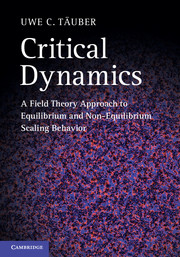Book contents
- Frontmatter
- Dedication
- Contents
- Preface
- Part I Near-equilibrium critical dynamics
- 1 Equilibrium critical phenomena
- 2 Stochastic dynamics
- 3 Dynamic scaling
- 4 Dynamic perturbation theory
- 5 Dynamic renormalization group
- 6 Hydrodynamic modes and reversible mode couplings
- 7 Phase transitions in quantum systems
- Part II Scale invariance in non-equilibrium systems
- Index
- References
2 - Stochastic dynamics
from Part I - Near-equilibrium critical dynamics
Published online by Cambridge University Press: 05 June 2014
- Frontmatter
- Dedication
- Contents
- Preface
- Part I Near-equilibrium critical dynamics
- 1 Equilibrium critical phenomena
- 2 Stochastic dynamics
- 3 Dynamic scaling
- 4 Dynamic perturbation theory
- 5 Dynamic renormalization group
- 6 Hydrodynamic modes and reversible mode couplings
- 7 Phase transitions in quantum systems
- Part II Scale invariance in non-equilibrium systems
- Index
- References
Summary
In this chapter, we develop the basic tools for our study of dynamic critical phenomena. We introduce dynamic correlation, response, and relaxation functions, and explore their general features. In the linear response regime, these quantities can be expressed in terms of equilibrium properties. A fluctuation-dissipation theorem then relates dynamic response and correlation functions. Under more general non-equilibrium conditions, we must resort to the theory of stochastic processes. The probability P1(x, t) of finding a certain physical configuration x at time t is governed by a master equation. On the level of such a ‘microscopic’ description, we discuss the detailed-balance conditions which guarantee that P1(x, t) approaches the probability distribution of an equilibrium statistical ensemble as t → ∞. Taking the continuum limit for the variable(s) x, we are led to the Kramers–Moyal expansion, which often reduces to a Fokker–Planck equation. Three important examples elucidate these concepts further, and also serve to introduce some calculational methods; these are biased one-dimensional random walks, a simple population dynamics model, and kinetic Ising systems. We then venture towards a more ‘mesoscopic’ viewpoint which focuses on the long-time dynamics of certain characteristic, ‘relevant’ quantities. Assuming an appropriate separation of time scales, the remaining ‘fast’ degrees of freedom are treated as stochastic noise. As an introduction to these concepts, the Langevin–Einstein theory of free Brownian motion is reviewed, and the associated Fokker–Planck equation is solved explicitly.
- Type
- Chapter
- Information
- Critical DynamicsA Field Theory Approach to Equilibrium and Non-Equilibrium Scaling Behavior, pp. 45 - 95Publisher: Cambridge University PressPrint publication year: 2014

